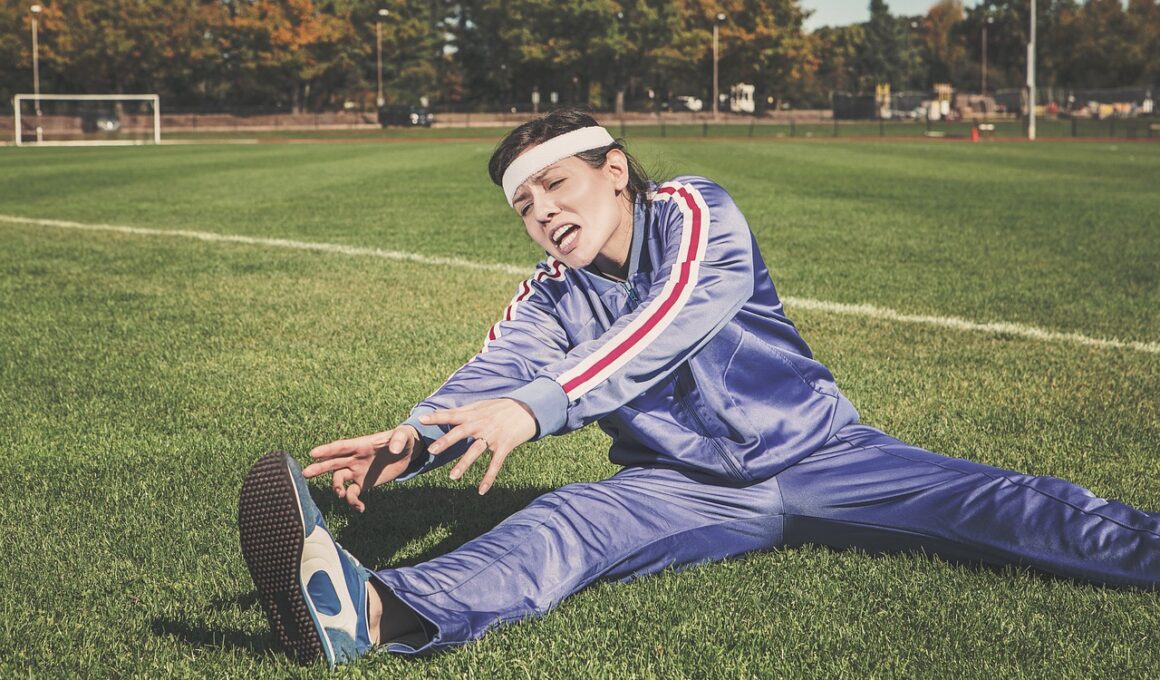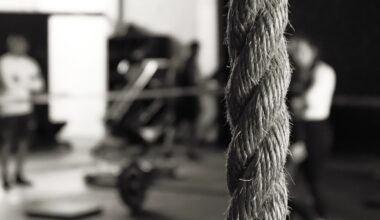Tracking Mobility Progress: Tools and Tips for Functional Fitness
Understanding mobility is essential for those engaged in functional fitness. Mobility refers to the ability of our joints to move freely through a range of motion. Improving mobility can lead to enhanced performance and decrease the risk of injuries. Various tools are available that can assist individuals in tracking their mobility progress effectively. Mobile applications specifically designed for fitness tracking often provide valuable insights. Regular assessments using these apps can help pinpoint strengths and weaknesses. Furthermore, wearable technology can play a significant role. Devices like fitness trackers or smartwatches can monitor joint angles and movement patterns over time. These continuous insights can inform adjustments in workout routines. Additionally, keeping a journal can be incredibly beneficial. Documenting workouts, stretches, and feelings can reveal patterns that help identify progress. However, it is important to set realistic goals when managing mobility improvement. Gradual adjustments allows the body to adapt. Engaging with physical therapists or trainers might also provide insights tailored to individual needs. Overall, tracking mobility is a multifaceted approach that gets more effective with the right tools.
Essential Mobility Assessment Tools
To track mobility effectively, utilizing a range of assessment tools is crucial. One popular method includes the use of the Functional Movement Screen (FMS). This system identifies limitations in movement patterns while assessing potential injury risks. It effectively categorizes mobility and stability into specific assessments. Another option is the use of goniometers, which measure joint range of motion precisely. Coaches and trainers frequently use this device during personal assessment sessions. Additionally, specialized mobile applications, such as MyMobility, allow users to assess and log their mobility routines from home. Implementing regular assessments enhances accountability in mobility efforts. An alternative involves yoga poses that can naturally promote mobility improvements, such as Downward Dog or Pigeon Pose. Flexibility in these exercises gives valuable feedback about mobility levels. Moreover, assessments can vary based on individual goals. For example, athletes might require sport-specific measurements. Engaging different methods helps create a comprehensive understanding of one’s mobility status. Regular comparisons of results also illustrate progress over time. In doing so, clients can set new targets for improvement, fostering a lifestyle centered around functional fitness.
Utilizing mobility tools goes hand in hand with defining a mobility improvement strategy. Creating a strategic plan helps in setting clear, achievable goals. This strategic process begins by identifying specific areas of focus based on assessment results. For instance, if hip mobility is limited, targeted stretches and exercises can be introduced. There are various mobility drills, including dynamic stretches or foam rolling routines, both of which enhance joint function. The inclusion of resistance bands can also facilitate improved range of motion. Further contribution to mobility strategies could include integrating guided videos from reputable sources. Instructional videos provide visual cues to ensure that exercises are performed correctly. Calendars can serve as both reminders and trackers for daily mobility sessions. Consistency is key, ensuring that mobility work becomes part of the fitness routine. Additionally, varying intensity and duration keeps the strategy engaging, thus sustaining motivation. Setting milestones provides positive reinforcement as progress unfolds. Celebrating small victories creates a more enjoyable experience. Remember that a holistic approach focusing on overall wellbeing will yield the highest benefits in the long-term mobility journey.
Incorporating Mobility into Daily Routines
Incorporating mobility exercises into daily routines is essential for optimal performance in functional fitness. Simple strategies can help seamlessly integrate these practices. For instance, beginning each workout with a dynamic warm-up prepares the body for movement without risking injury. Adding mobility work into cool-down sessions reinforces joint flexibility after intense workouts. Stretching while watching television or during breaks at work promotes routine mobility practice. Furthermore, setting reminders or alarms throughout the day encourages movement, preventing stiffness. Morning routines can serve as an excellent opportunity for mobility work, enhancing flexibility and readiness for daily activities. Consider incorporating popular mobility exercises, such as cat-cow stretches or ankle rolls, into these routines. Moreover, many people hold sedentary jobs. Combatting the effects of prolonged sitting can be achieved through regular standing, stretching, or short walks. Staying alert is facilitated through such movements. Group classes focused on mobility also provide social incentives to maintain routines. Group settings engage and motivate individuals working on mobility enhancement. Remember, small, consistent actions lead to sustainable changes in mobility over time. Tracking these improvements becomes easier with a consistent routine established.
Education plays a significant role in improving mobility and ensuring participants understand its importance in functional fitness. Knowledge about the body, joint actions, and muscle engagement empowers individuals. Watching online tutorial videos from experts or reading books on mobility can deepen understanding. Understanding biomechanics is critical in choosing the appropriate mobilization techniques. It’s beneficial to participate in workshops or seminars that emphasize mobility strategies in fitness regimes. Certified professionals often offer specialized courses focused on mobility improvement. Additionally, engaging in community discussions can yield valuable insights. Numerous fitness communities can provide support and share experiences. Social media platforms host various fitness groups, many focusing specifically on mobility improvement. Connecting with like-minded individuals allows for the exchange of tips, tools, and success stories. Consider joining online forums and health blogs to stay updated on the latest mobility techniques. Engaging with experts through Q&A sessions can clarify doubts regarding mobility-related issues. Overall, a well-rounded education enhances practice and engages individuals deeply with their fitness journey. Cultivating an ongoing thirst for knowledge will further strengthen one’s mobility approach.
Measuring Progress: Effective Techniques
Measuring progress in mobility requires effective and consistent techniques. Establishing a baseline assessment offers a starting point for tracking improvement. Recording initial measurements on specific mobility benchmarks, such as hamstring flexibility or shoulder range, provides tangible data. Regularly repeating assessments every few weeks helps in monitoring progression accurately. Another significant method involves using a simple flexibility test. Clients can perform stretches to assess how they feel over time. Recording perceived improvements, such as reduced tightness or enhanced joint movement, can indicate noteworthy enhancement. Additionally, visual documentation provides an engaging way to measure progress. Taking progress photos through visual comparisons allows individuals to see their development better. Maintaining a consistent structure, like a fitness journal, helps log daily activities focusing on mobility practices. Smartphone apps can assist in tracking workouts, recording initial evaluations, and subsequent changes. These visual aids not only motivate but keep individuals engaged in their mobility routine. Sharing progress within fitness communities also fosters accountability, encouraging others to promote growth within the group. Ultimately, these techniques help maintain focus, resulting in successful mobility improvements over time.
In conclusion, tracking mobility progress is vital in achieving beneficial outcomes in functional fitness regimes. By utilizing an array of tools, adopting structured routines, and educating oneself, individuals can significantly enhance their mobility. It creates a knowledgeable foundation where exercises can be consistently performed to achieve a greater understanding of one’s body. Regular assessments help pinpoint areas of focus while encouraging measurable growth. Incorporating these practices into daily routines fosters a more holistic approach to fitness. Establishing a community around shared knowledge creates motivation and a sense of accountability. It is always essential to strive for gradual improvement while celebrating milestones along the journey. Working towards enhancing mobility is a continuous process, fostering better physical health and wellbeing. Even small improvements can contribute to overall fitness and quality of life. Therefore, maintaining a proactive and engaged approach towards mobility work allows individuals to progress effectively. Embrace the journey towards enhanced mobility with patience and persistence, ensuring that goals are aligned with personal fitness aspirations. Ultimately, the benefits of improved mobility become evident, shining through in the performance of daily tasks and activities.
Final Tips for Sustaining Mobility Improvements
To ensure continuous mobility improvement, consistency remains the foremost goal. Regularly engaging in mobility exercises without skipping sessions builds fundamental strength and flexibility. Individuals are encouraged to integrate variety into their routines, preventing boredom and encouraging sustained interest. Moreover, tracking progress through different means, such as journals and apps, offers motivational reinforcement. Focusing on the importance of rest is equally crucial. Allowing time for recovery prevents overuse injuries while promoting better adaptability in mobility workouts. Regular reassessments provide motivation; as improvements become evident, individuals are encouraged to push limits further. Seeking feedback from trainers or peers can enhance performance and provide alternate strategies for improvement. Exploring new exercises or tools not only spices up routines but also fosters overall adaptability. Moreover, engaging in discussions about mobility work keeps knowledge fresh and helps motivate continued practice. Sharing personal experiences and successes inspires others both within and outside the fitness community. Committing to long-term goals while remaining patient in the process encourages continued growth. Every small step taken toward greater mobility pays off significantly in the long run, showcasing hard-earned results in functional fitness endeavors.


